Attached files
| file | filename |
|---|---|
| 8-K - 8-K - DYCOM INDUSTRIES INC | dy-20210601.htm |
| EX-99.2 - EX-99.2 - DYCOM INDUSTRIES INC | dyfy2022q1non-gaapreconcil.htm |
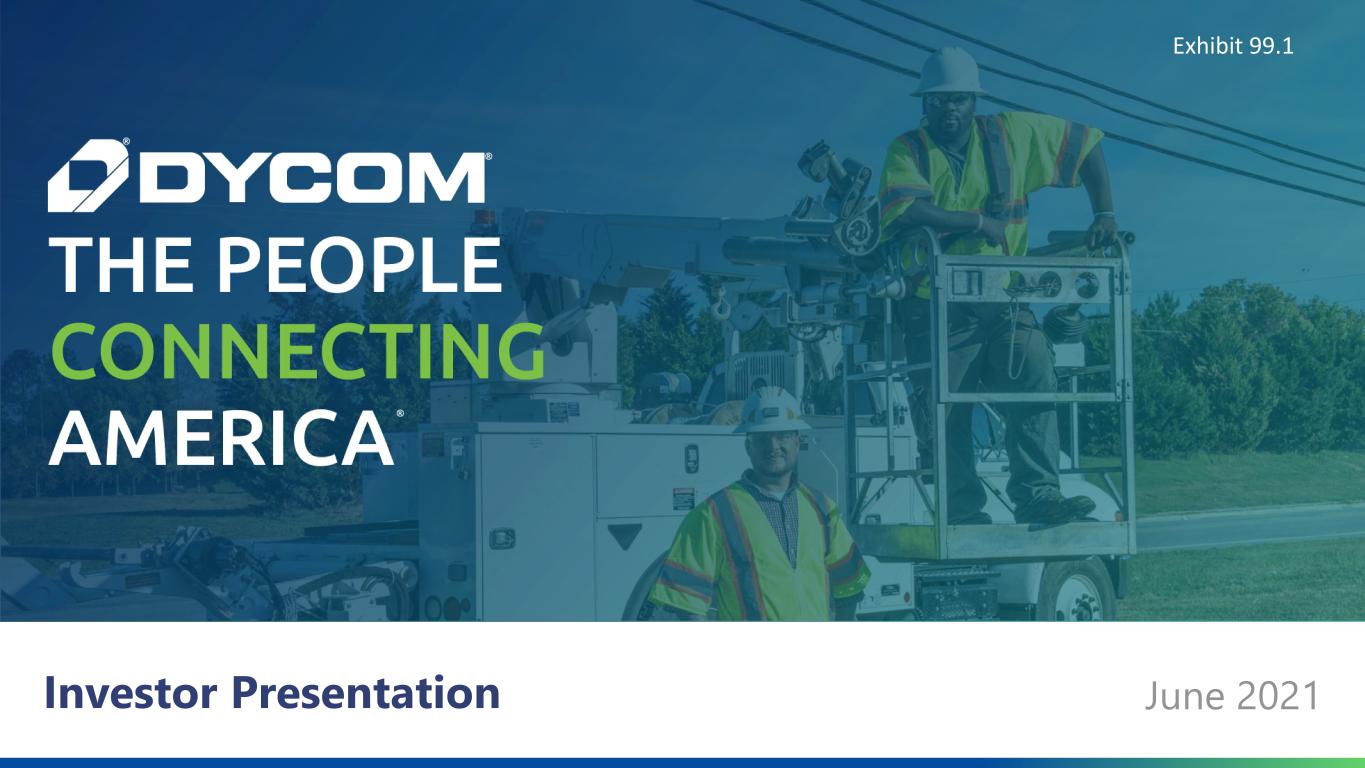
June 2021Investor Presentation Exhibit 99.1
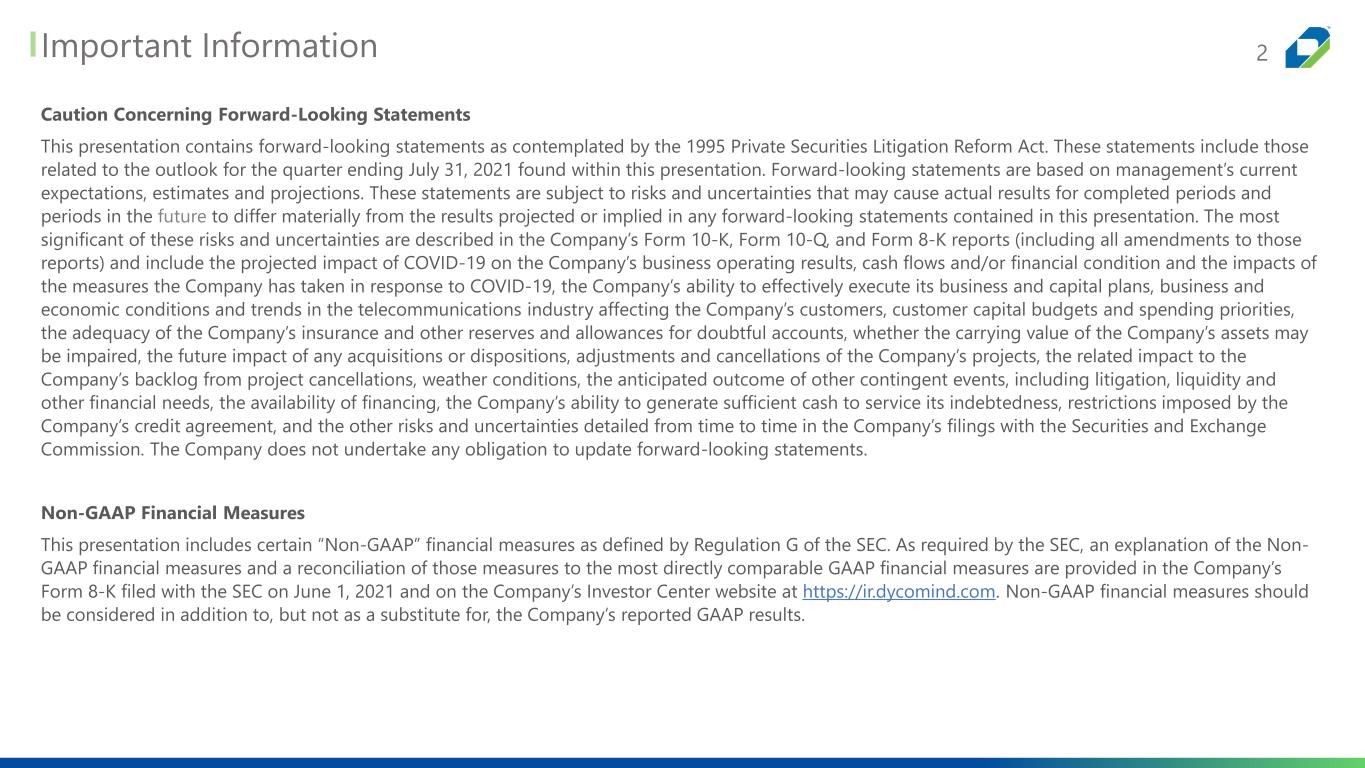
Caution Concerning Forward-Looking Statements This presentation contains forward-looking statements as contemplated by the 1995 Private Securities Litigation Reform Act. These statements include those related to the outlook for the quarter ending July 31, 2021 found within this presentation. Forward-looking statements are based on management’s current expectations, estimates and projections. These statements are subject to risks and uncertainties that may cause actual results for completed periods and periods in the future to differ materially from the results projected or implied in any forward-looking statements contained in this presentation. The most significant of these risks and uncertainties are described in the Company’s Form 10-K, Form 10-Q, and Form 8-K reports (including all amendments to those reports) and include the projected impact of COVID-19 on the Company’s business operating results, cash flows and/or financial condition and the impacts of the measures the Company has taken in response to COVID-19, the Company’s ability to effectively execute its business and capital plans, business and economic conditions and trends in the telecommunications industry affecting the Company’s customers, customer capital budgets and spending priorities, the adequacy of the Company’s insurance and other reserves and allowances for doubtful accounts, whether the carrying value of the Company’s assets may be impaired, the future impact of any acquisitions or dispositions, adjustments and cancellations of the Company’s projects, the related impact to the Company’s backlog from project cancellations, weather conditions, the anticipated outcome of other contingent events, including litigation, liquidity and other financial needs, the availability of financing, the Company’s ability to generate sufficient cash to service its indebtedness, restrictions imposed by the Company’s credit agreement, and the other risks and uncertainties detailed from time to time in the Company’s filings with the Securities and Exchange Commission. The Company does not undertake any obligation to update forward-looking statements. Non-GAAP Financial Measures This presentation includes certain “Non-GAAP” financial measures as defined by Regulation G of the SEC. As required by the SEC, an explanation of the Non- GAAP financial measures and a reconciliation of those measures to the most directly comparable GAAP financial measures are provided in the Company’s Form 8-K filed with the SEC on June 1, 2021 and on the Company’s Investor Center website at https://ir.dycomind.com. Non-GAAP financial measures should be considered in addition to, but not as a substitute for, the Company’s reported GAAP results. Important Information 2
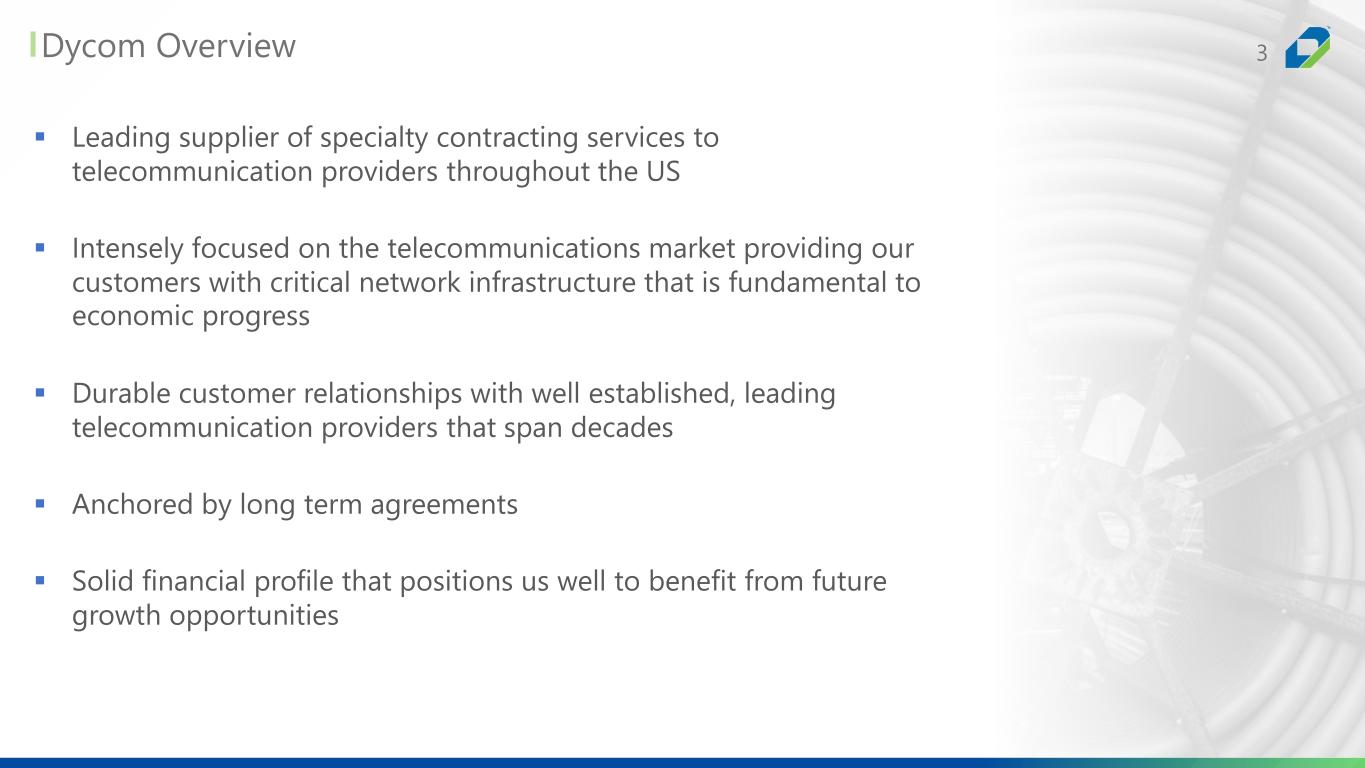
3Dycom Overview Leading supplier of specialty contracting services to telecommunication providers throughout the US Intensely focused on the telecommunications market providing our customers with critical network infrastructure that is fundamental to economic progress Durable customer relationships with well established, leading telecommunication providers that span decades Anchored by long term agreements Solid financial profile that positions us well to benefit from future growth opportunities
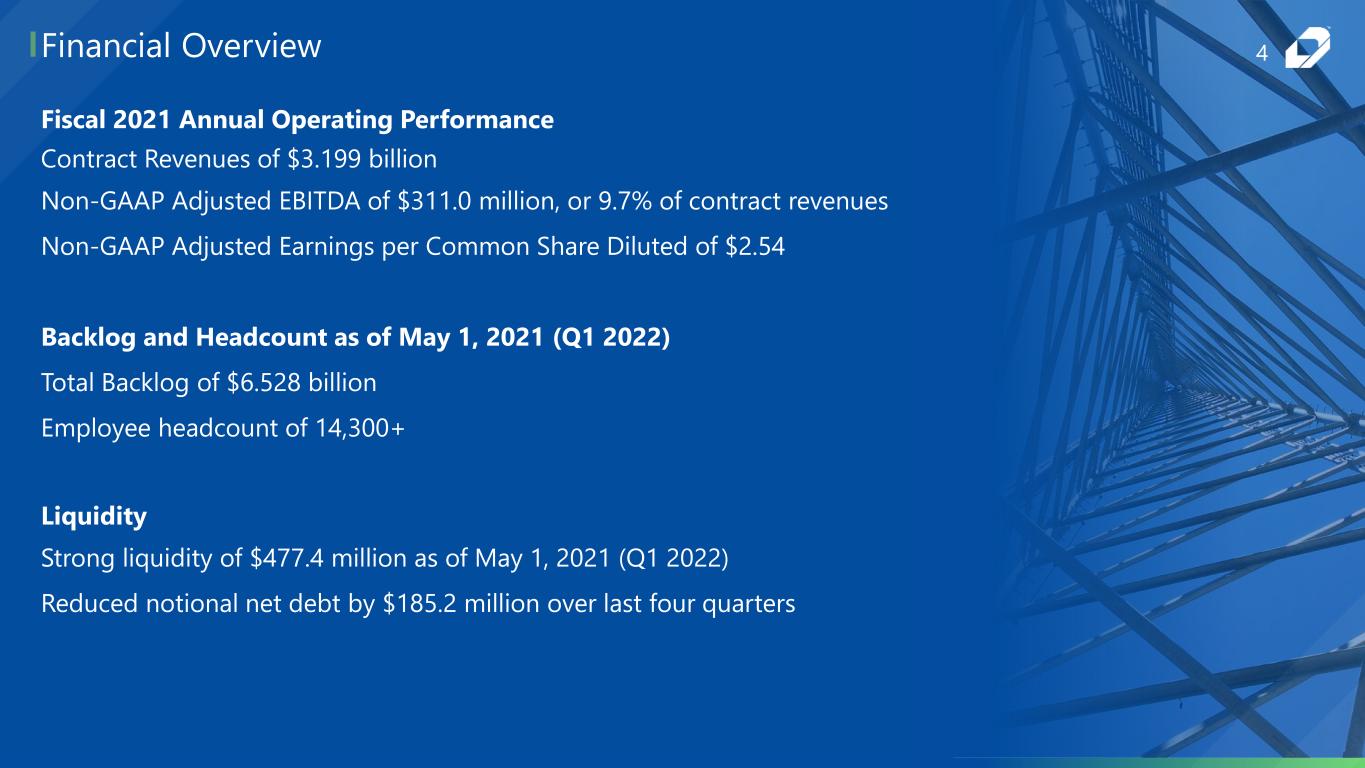
Fiscal 2021 Annual Operating Performance Contract Revenues of $3.199 billion Non-GAAP Adjusted EBITDA of $311.0 million, or 9.7% of contract revenues Non-GAAP Adjusted Earnings per Common Share Diluted of $2.54 Backlog and Headcount as of May 1, 2021 (Q1 2022) Total Backlog of $6.528 billion Employee headcount of 14,300+ Liquidity Strong liquidity of $477.4 million as of May 1, 2021 (Q1 2022) Reduced notional net debt by $185.2 million over last four quarters 4Financial Overview
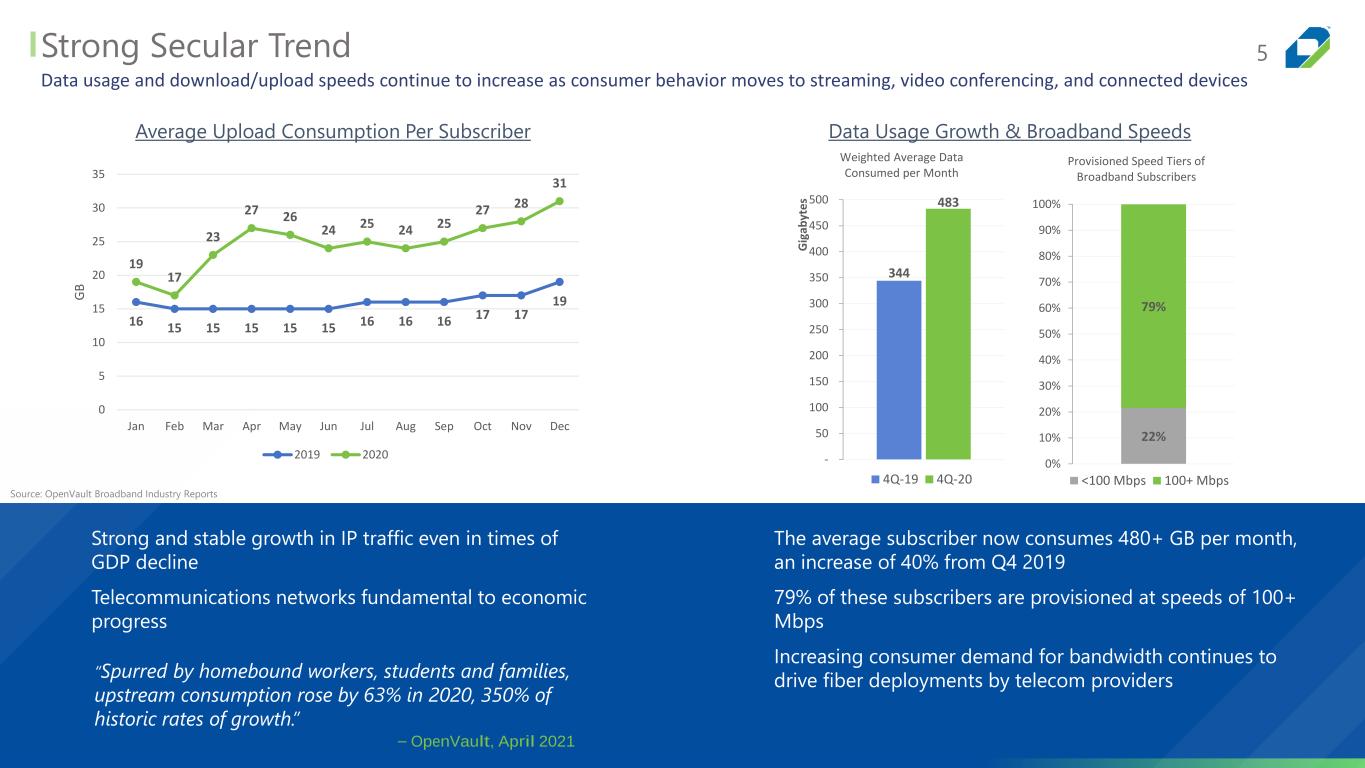
344 483 - 50 100 150 200 250 300 350 400 450 500 G ig a b y te s Weighted Average Data Consumed per Month 4Q-19 4Q-20 5Strong Secular Trend Average Upload Consumption Per Subscriber Strong and stable growth in IP traffic even in times of GDP decline Telecommunications networks fundamental to economic progress Data Usage Growth & Broadband Speeds The average subscriber now consumes 480+ GB per month, an increase of 40% from Q4 2019 79% of these subscribers are provisioned at speeds of 100+ Mbps Increasing consumer demand for bandwidth continues to drive fiber deployments by telecom providers Source: OpenVault Broadband Industry Reports 22% 79% 0% 10% 20% 30% 40% 50% 60% 70% 80% 90% 100% Provisioned Speed Tiers of Broadband Subscribers <100 Mbps 100+ Mbps 16 15 15 15 15 15 16 16 16 17 17 19 19 17 23 27 26 24 25 24 25 27 28 31 0 5 10 15 20 25 30 35 Jan Feb Mar Apr May Jun Jul Aug Sep Oct Nov Dec G B 2019 2020 “Spurred by homebound workers, students and families, upstream consumption rose by 63% in 2020, 350% of historic rates of growth.” – OpenVault, April 2021 Data usage and download/upload speeds continue to increase as consumer behavior moves to streaming, video conferencing, and connected devices
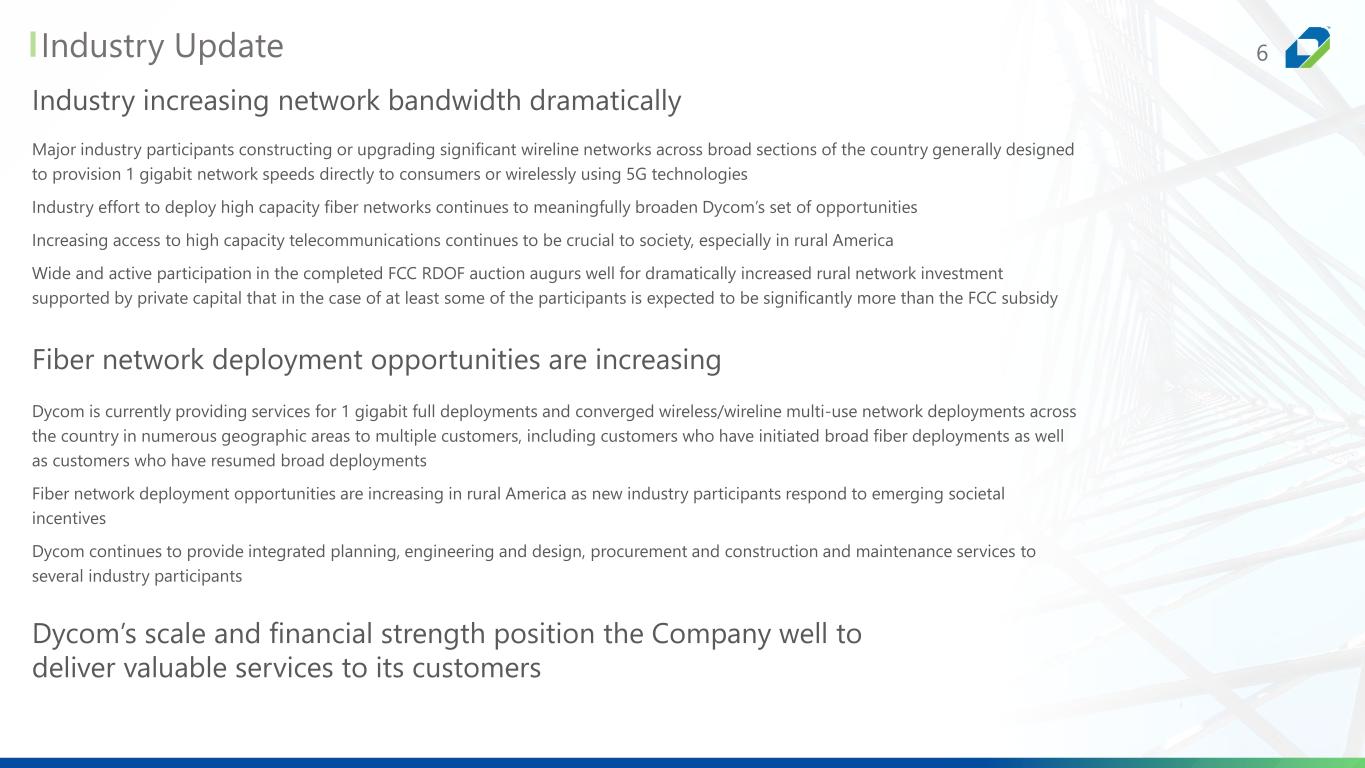
6Industry Update Major industry participants constructing or upgrading significant wireline networks across broad sections of the country generally designed to provision 1 gigabit network speeds directly to consumers or wirelessly using 5G technologies Industry effort to deploy high capacity fiber networks continues to meaningfully broaden Dycom’s set of opportunities Increasing access to high capacity telecommunications continues to be crucial to society, especially in rural America Wide and active participation in the completed FCC RDOF auction augurs well for dramatically increased rural network investment supported by private capital that in the case of at least some of the participants is expected to be significantly more than the FCC subsidy Industry increasing network bandwidth dramatically Fiber network deployment opportunities are increasing Dycom’s scale and financial strength position the Company well to deliver valuable services to its customers Dycom is currently providing services for 1 gigabit full deployments and converged wireless/wireline multi-use network deployments across the country in numerous geographic areas to multiple customers, including customers who have initiated broad fiber deployments as well as customers who have resumed broad deployments Fiber network deployment opportunities are increasing in rural America as new industry participants respond to emerging societal incentives Dycom continues to provide integrated planning, engineering and design, procurement and construction and maintenance services to several industry participants
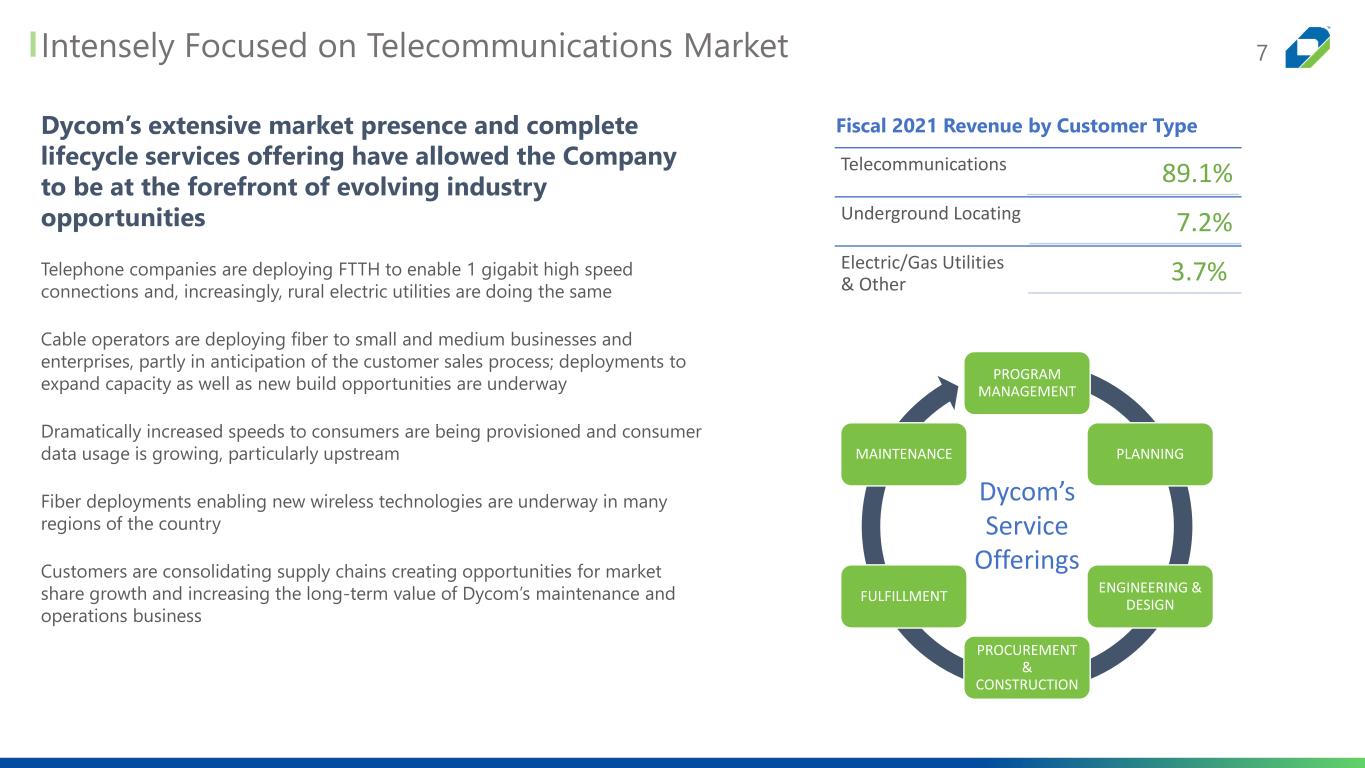
7Intensely Focused on Telecommunications Market Fiscal 2021 Revenue by Customer Type PROGRAM MANAGEMENT PLANNING ENGINEERING & DESIGN PROCUREMENT & CONSTRUCTION FULFILLMENT MAINTENANCE Telecommunications 89.1% Underground Locating 7.2% Electric/Gas Utilities & Other 3.7% Dycom’s extensive market presence and complete lifecycle services offering have allowed the Company to be at the forefront of evolving industry opportunities Telephone companies are deploying FTTH to enable 1 gigabit high speed connections and, increasingly, rural electric utilities are doing the same Cable operators are deploying fiber to small and medium businesses and enterprises, partly in anticipation of the customer sales process; deployments to expand capacity as well as new build opportunities are underway Dramatically increased speeds to consumers are being provisioned and consumer data usage is growing, particularly upstream Fiber deployments enabling new wireless technologies are underway in many regions of the country Customers are consolidating supply chains creating opportunities for market share growth and increasing the long-term value of Dycom’s maintenance and operations business Dycom’s Service Offerings
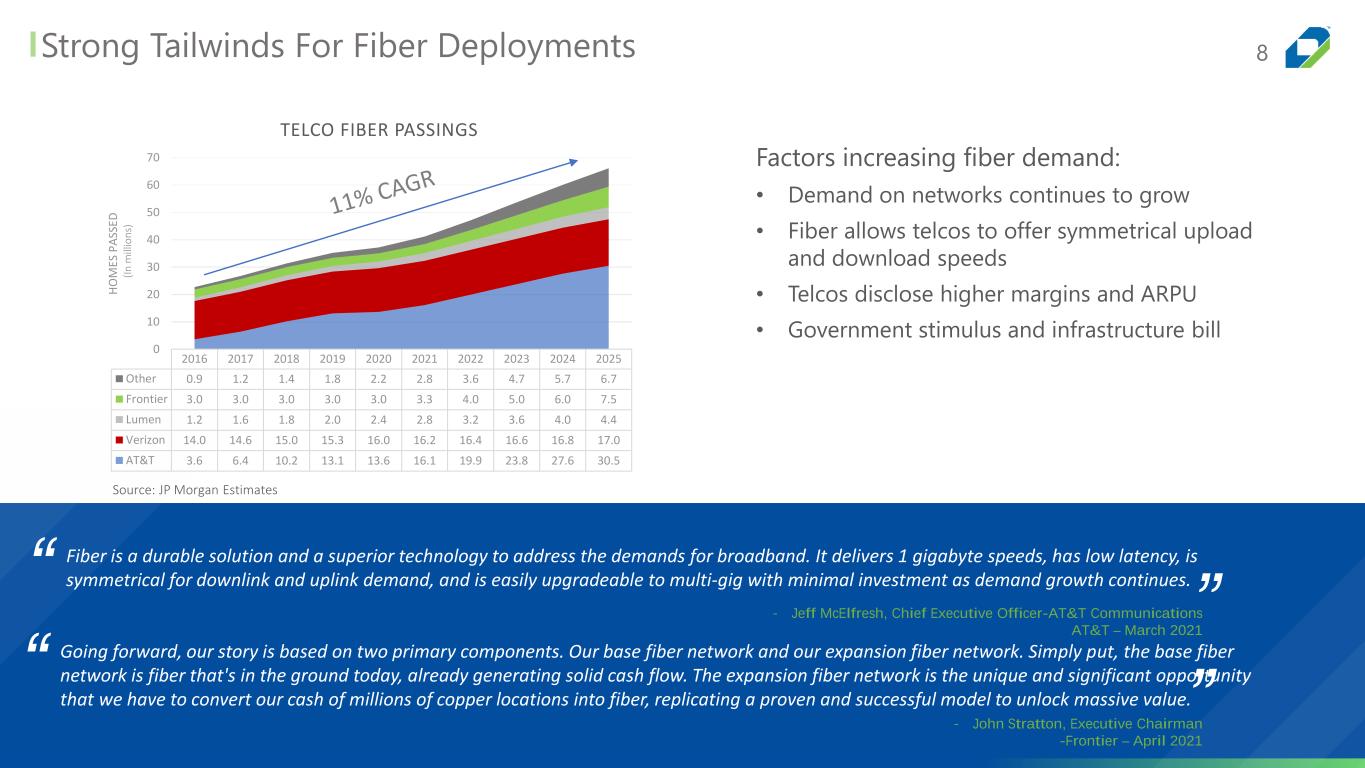
2016 2017 2018 2019 2020 2021 2022 2023 2024 2025 Other 0.9 1.2 1.4 1.8 2.2 2.8 3.6 4.7 5.7 6.7 Frontier 3.0 3.0 3.0 3.0 3.0 3.3 4.0 5.0 6.0 7.5 Lumen 1.2 1.6 1.8 2.0 2.4 2.8 3.2 3.6 4.0 4.4 Verizon 14.0 14.6 15.0 15.3 16.0 16.2 16.4 16.6 16.8 17.0 AT&T 3.6 6.4 10.2 13.1 13.6 16.1 19.9 23.8 27.6 30.5 0 10 20 30 40 50 60 70 H O M E S P A S S E D TELCO FIBER PASSINGS 8Strong Tailwinds For Fiber Deployments Factors increasing fiber demand: • Demand on networks continues to grow • Fiber allows telcos to offer symmetrical upload and download speeds • Telcos disclose higher margins and ARPU • Government stimulus and infrastructure bill Fiber is a durable solution and a superior technology to address the demands for broadband. It delivers 1 gigabyte speeds, has low latency, is symmetrical for downlink and uplink demand, and is easily upgradeable to multi-gig with minimal investment as demand growth continues. - Jeff McElfresh, Chief Executive Officer-AT&T Communications AT&T – March 2021 Source: JP Morgan Estimates (I n m ill io n s) “ ” Going forward, our story is based on two primary components. Our base fiber network and our expansion fiber network. Simply put, the base fiber network is fiber that's in the ground today, already generating solid cash flow. The expansion fiber network is the unique and significant opportunity that we have to convert our cash of millions of copper locations into fiber, replicating a proven and successful model to unlock massive value. - John Stratton, Executive Chairman -Frontier – April 2021 “ ”
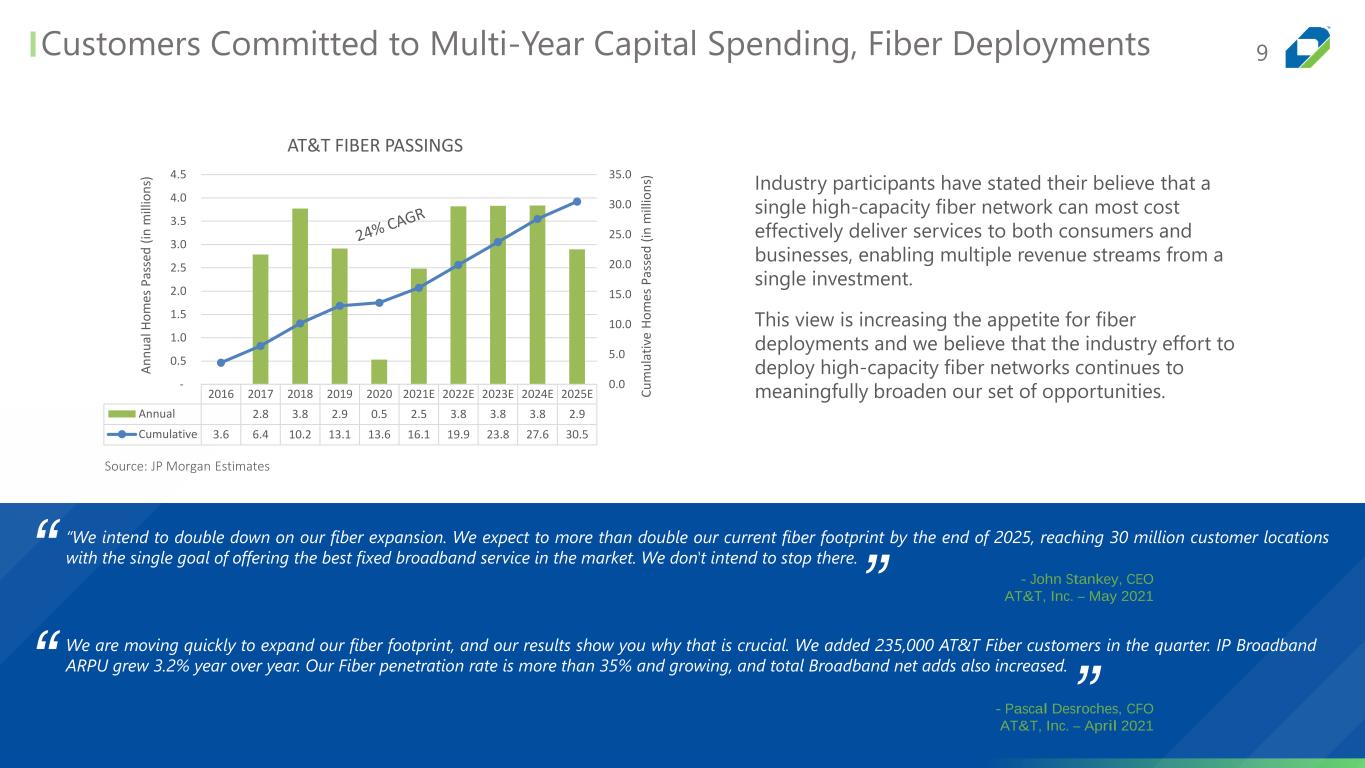
9Customers Committed to Multi-Year Capital Spending, Fiber Deployments “We intend to double down on our fiber expansion. We expect to more than double our current fiber footprint by the end of 2025, reaching 30 million customer locations with the single goal of offering the best fixed broadband service in the market. We don't intend to stop there.“ ” - John Stankey, CEOAT&T, Inc. – May 2021 We are moving quickly to expand our fiber footprint, and our results show you why that is crucial. We added 235,000 AT&T Fiber customers in the quarter. IP Broadband ARPU grew 3.2% year over year. Our Fiber penetration rate is more than 35% and growing, and total Broadband net adds also increased.“ ”- Pascal Desroches, CFO AT&T, Inc. – April 2021 2016 2017 2018 2019 2020 2021E 2022E 2023E 2024E 2025E Annual 2.8 3.8 2.9 0.5 2.5 3.8 3.8 3.8 2.9 Cumulative 3.6 6.4 10.2 13.1 13.6 16.1 19.9 23.8 27.6 30.5 0.0 5.0 10.0 15.0 20.0 25.0 30.0 35.0 - 0.5 1.0 1.5 2.0 2.5 3.0 3.5 4.0 4.5 C u m u la ti ve H o m e s P a ss e d ( in m il li o n s) A n n u a l H o m e s P a ss e d ( in m il li o n s) AT&T FIBER PASSINGS Source: JP Morgan Estimates Industry participants have stated their believe that a single high-capacity fiber network can most cost effectively deliver services to both consumers and businesses, enabling multiple revenue streams from a single investment. This view is increasing the appetite for fiber deployments and we believe that the industry effort to deploy high-capacity fiber networks continues to meaningfully broaden our set of opportunities.
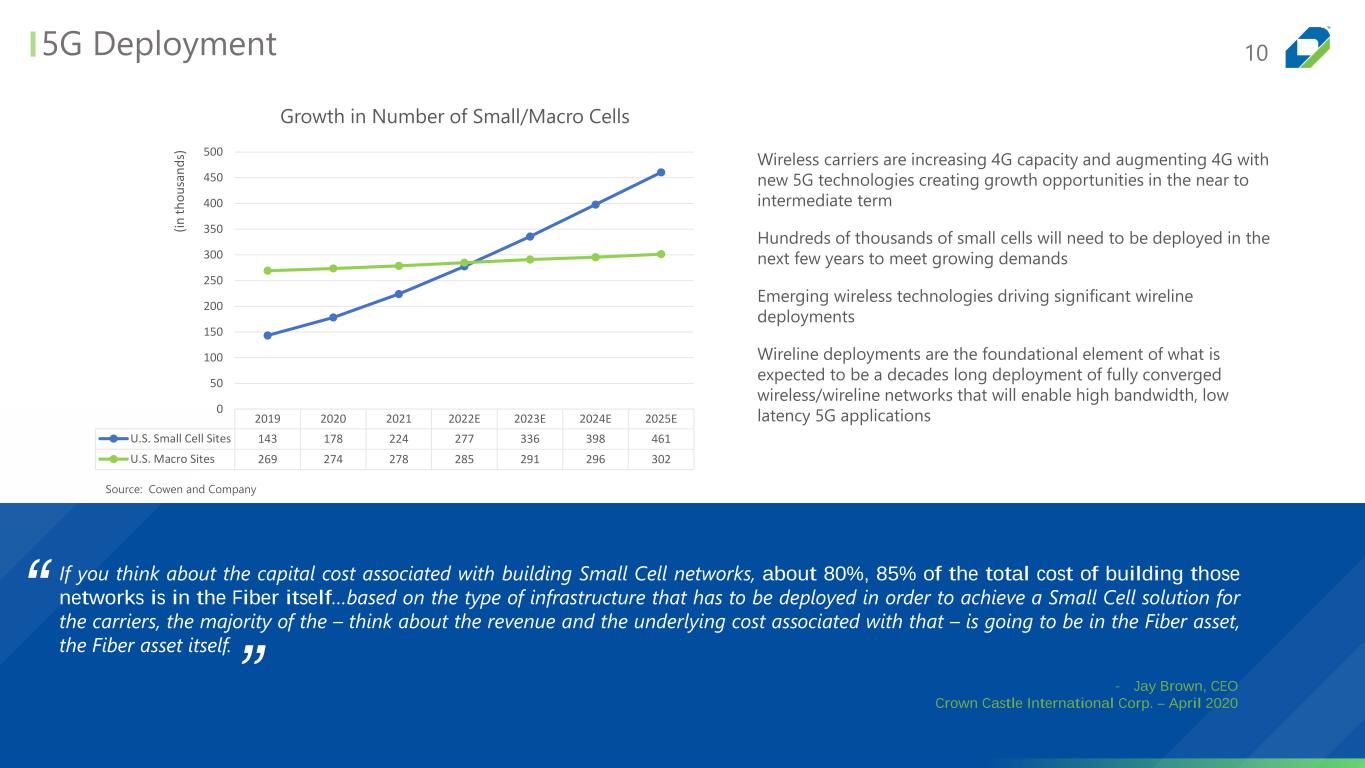
105G Deployment If you think about the capital cost associated with building Small Cell networks, about 80%, 85% of the total cost of building those networks is in the Fiber itself…based on the type of infrastructure that has to be deployed in order to achieve a Small Cell solution for the carriers, the majority of the – think about the revenue and the underlying cost associated with that – is going to be in the Fiber asset, the Fiber asset itself. “ ” - Jay Brown, CEO Crown Castle International Corp. – April 2020 Growth in Number of Small/Macro Cells Source: Cowen and Company 2019 2020 2021 2022E 2023E 2024E 2025E U.S. Small Cell Sites 143 178 224 277 336 398 461 U.S. Macro Sites 269 274 278 285 291 296 302 0 50 100 150 200 250 300 350 400 450 500 Wireless carriers are increasing 4G capacity and augmenting 4G with new 5G technologies creating growth opportunities in the near to intermediate term Hundreds of thousands of small cells will need to be deployed in the next few years to meet growing demands Emerging wireless technologies driving significant wireline deployments Wireline deployments are the foundational element of what is expected to be a decades long deployment of fully converged wireless/wireline networks that will enable high bandwidth, low latency 5G applications (i n t h o u sa n d s)
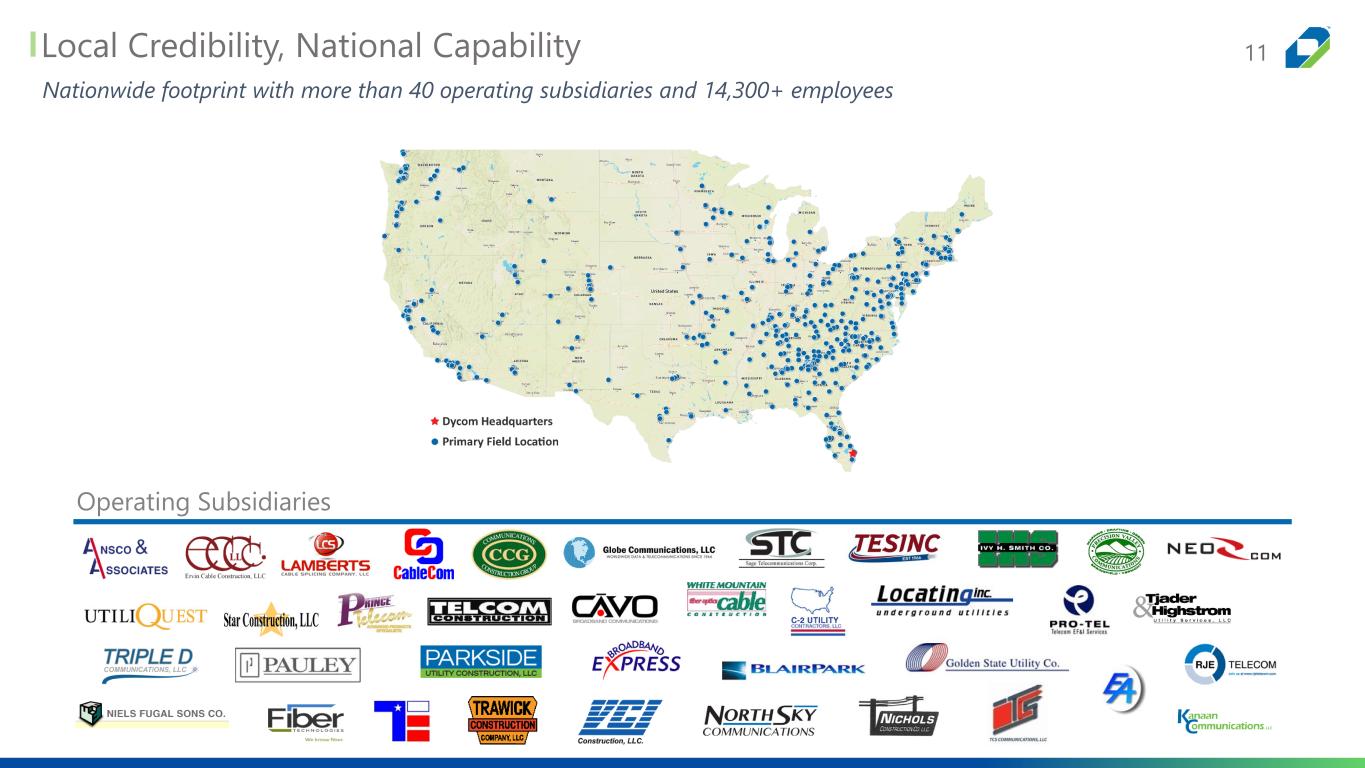
Local Credibility, National Capability Nationwide footprint with more than 40 operating subsidiaries and 14,300+ employees Operating Subsidiaries 11
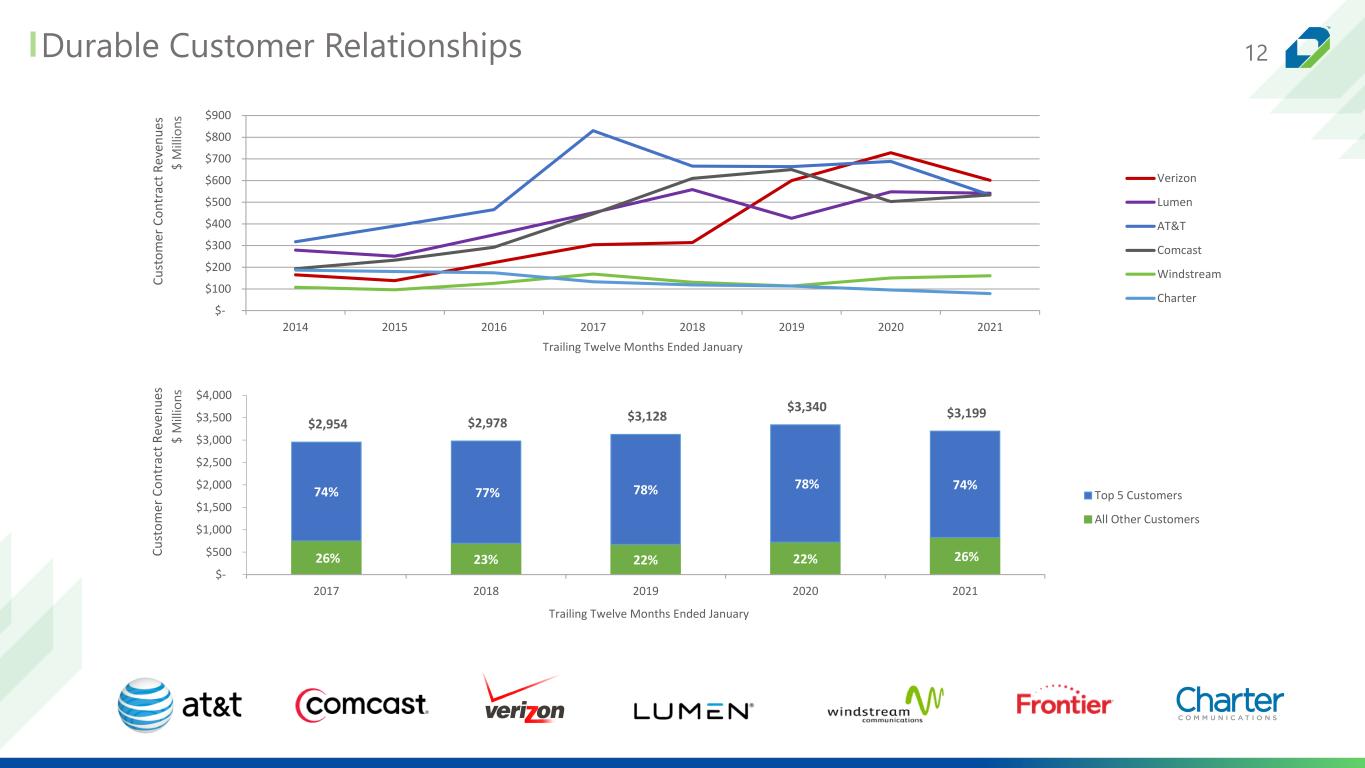
$- $100 $200 $300 $400 $500 $600 $700 $800 $900 2014 2015 2016 2017 2018 2019 2020 2021 C u st o m e r C o n tr a ct R e ve n u e s Trailing Twelve Months Ended January Verizon Lumen AT&T Comcast Windstream Charter 12Durable Customer Relationships $ M il li o n s 26% 23% 22% 22% 26% 74% 77% 78% 78% 74% $2,954 $2,978 $3,128 $3,340 $3,199 $- $500 $1,000 $1,500 $2,000 $2,500 $3,000 $3,500 $4,000 2017 2018 2019 2020 2021 C u st o m e r C o n tr a ct R e ve n u e s Trailing Twelve Months Ended January Top 5 Customers All Other Customers $ M il li o n s
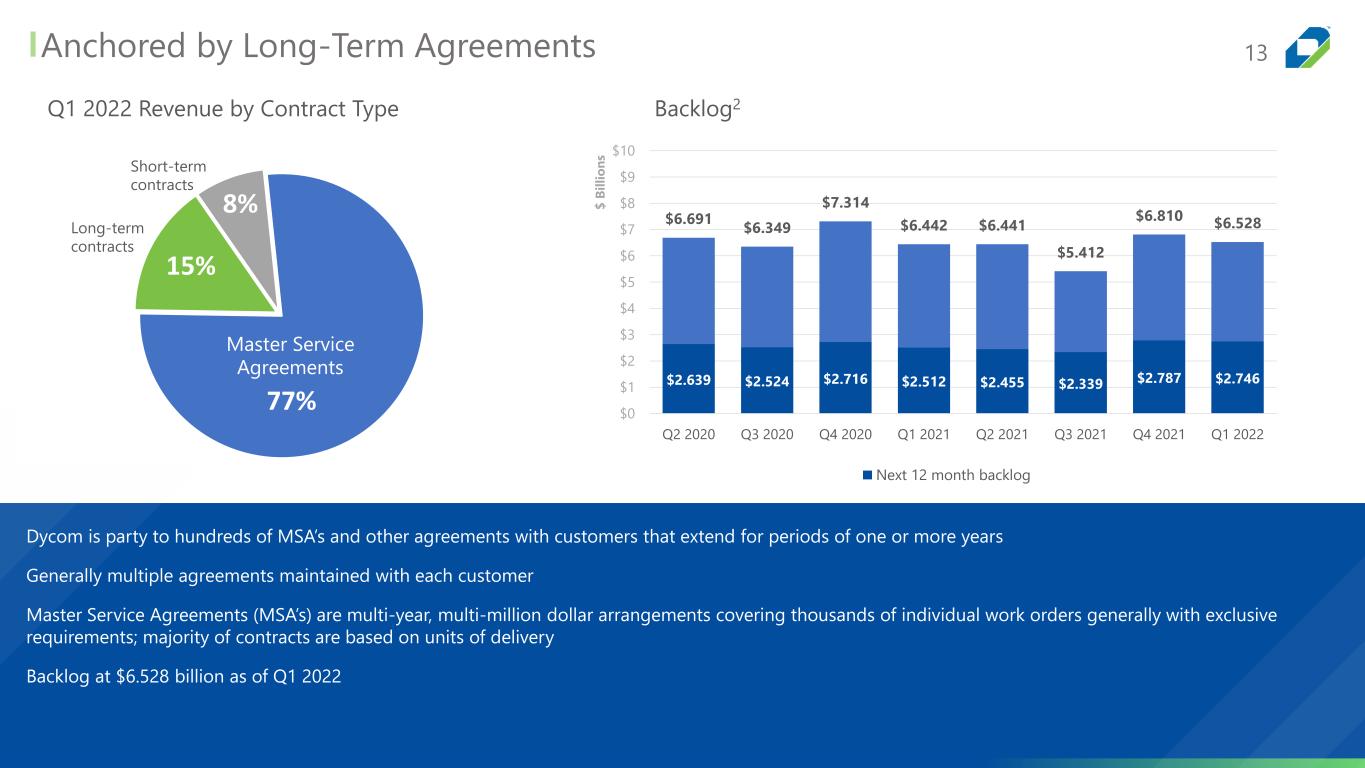
13Anchored by Long-Term Agreements Dycom is party to hundreds of MSA’s and other agreements with customers that extend for periods of one or more years Generally multiple agreements maintained with each customer Master Service Agreements (MSA’s) are multi-year, multi-million dollar arrangements covering thousands of individual work orders generally with exclusive requirements; majority of contracts are based on units of delivery Backlog at $6.528 billion as of Q1 2022 Q1 2022 Revenue by Contract Type 77% 15% 8% Master Service Agreements Long-term contracts Short-term contracts $2.639 $2.524 $2.716 $2.512 $2.455 $2.339 $2.787 $2.746 $6.691 $6.349 $7.314 $6.442 $6.441 $5.412 $6.810 $6.528 $0 $1 $2 $3 $4 $5 $6 $7 $8 $9 $10 Q2 2020 Q3 2020 Q4 2020 Q1 2021 Q2 2021 Q3 2021 Q4 2021 Q1 2022 $ B il li o n s Backlog2 Next 12 month backlog
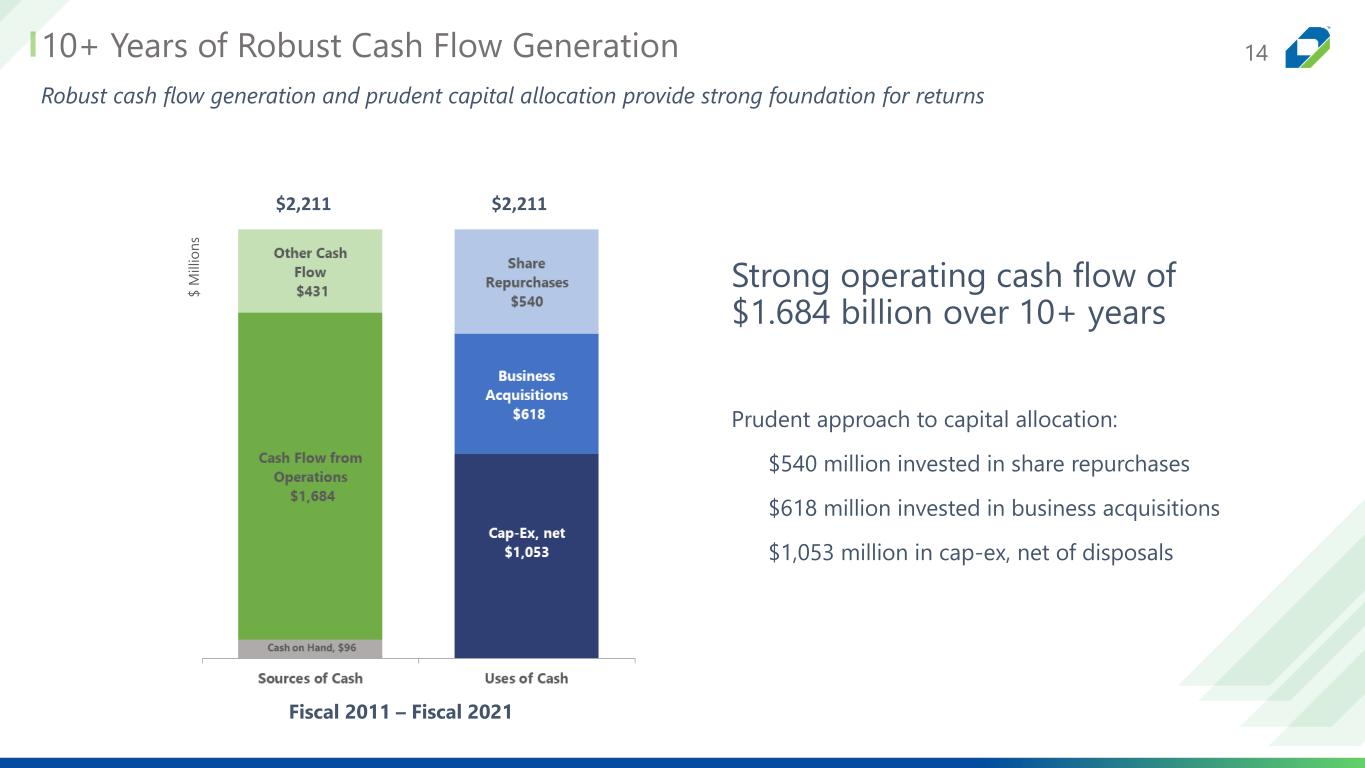
1410+ Years of Robust Cash Flow Generation Fiscal 2011 – Fiscal 2021 Robust cash flow generation and prudent capital allocation provide strong foundation for returns Strong operating cash flow of $1.684 billion over 10+ years Prudent approach to capital allocation: $540 million invested in share repurchases $618 million invested in business acquisitions $1,053 million in cap-ex, net of disposals $2,211 $2,211 $ M il li o n s
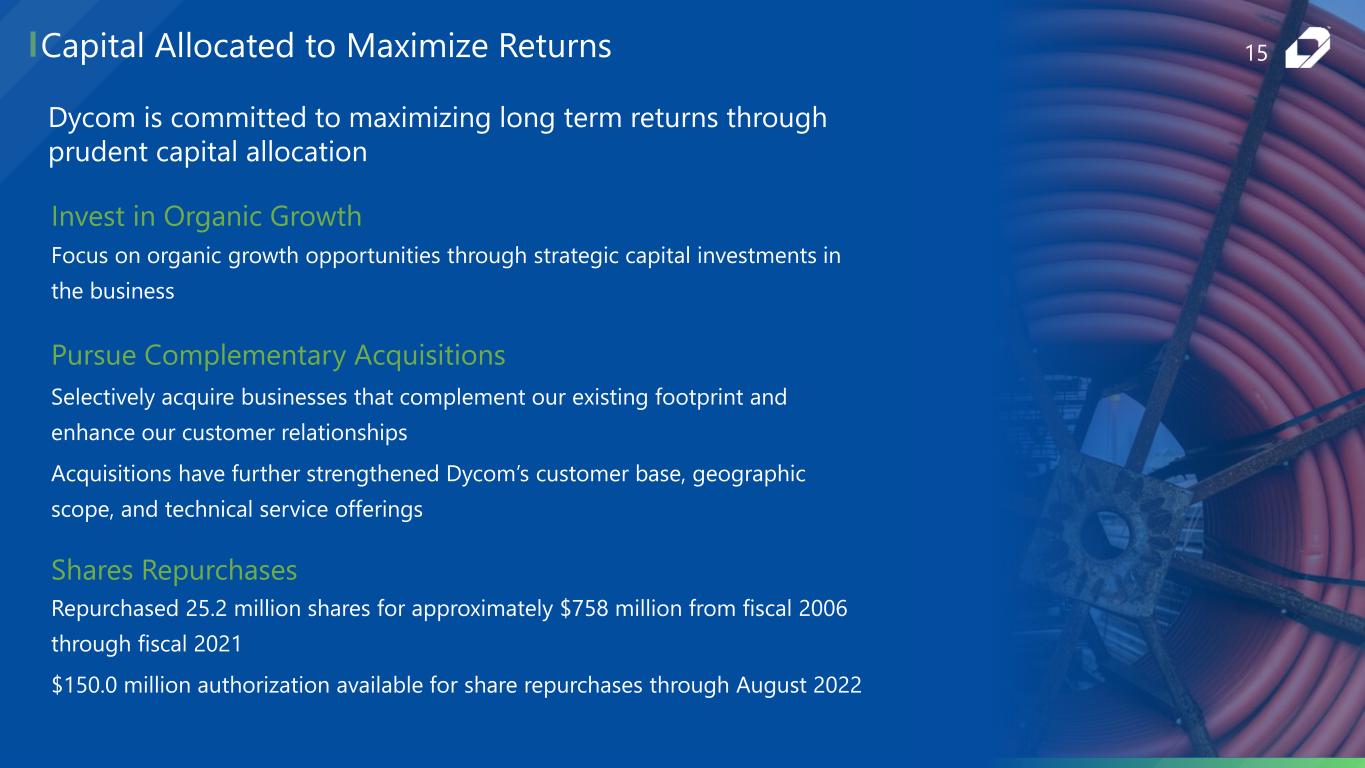
15Capital Allocated to Maximize Returns Focus on organic growth opportunities through strategic capital investments in the business Dycom is committed to maximizing long term returns through prudent capital allocation Repurchased 25.2 million shares for approximately $758 million from fiscal 2006 through fiscal 2021 $150.0 million authorization available for share repurchases through August 2022 Invest in Organic Growth Shares Repurchases Pursue Complementary Acquisitions Selectively acquire businesses that complement our existing footprint and enhance our customer relationships Acquisitions have further strengthened Dycom’s customer base, geographic scope, and technical service offerings
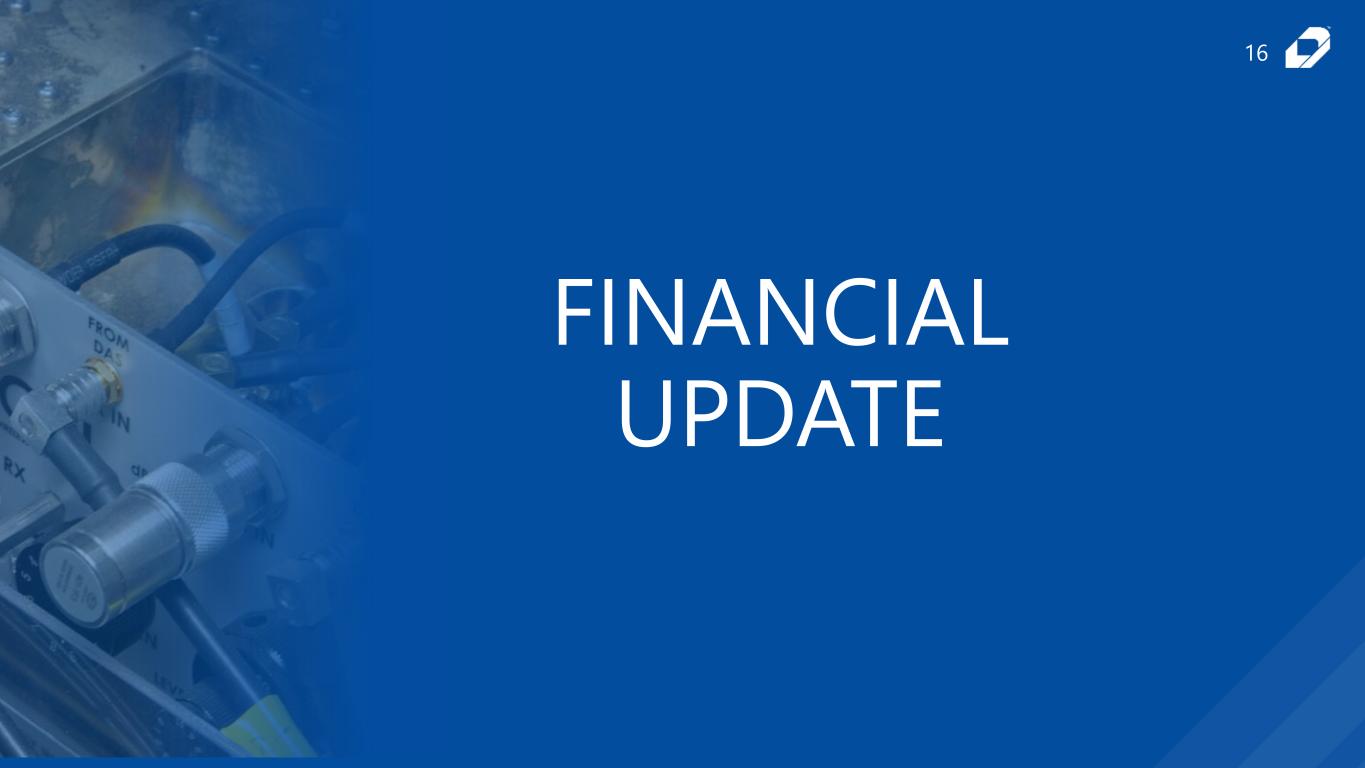
16 FINANCIAL UPDATE
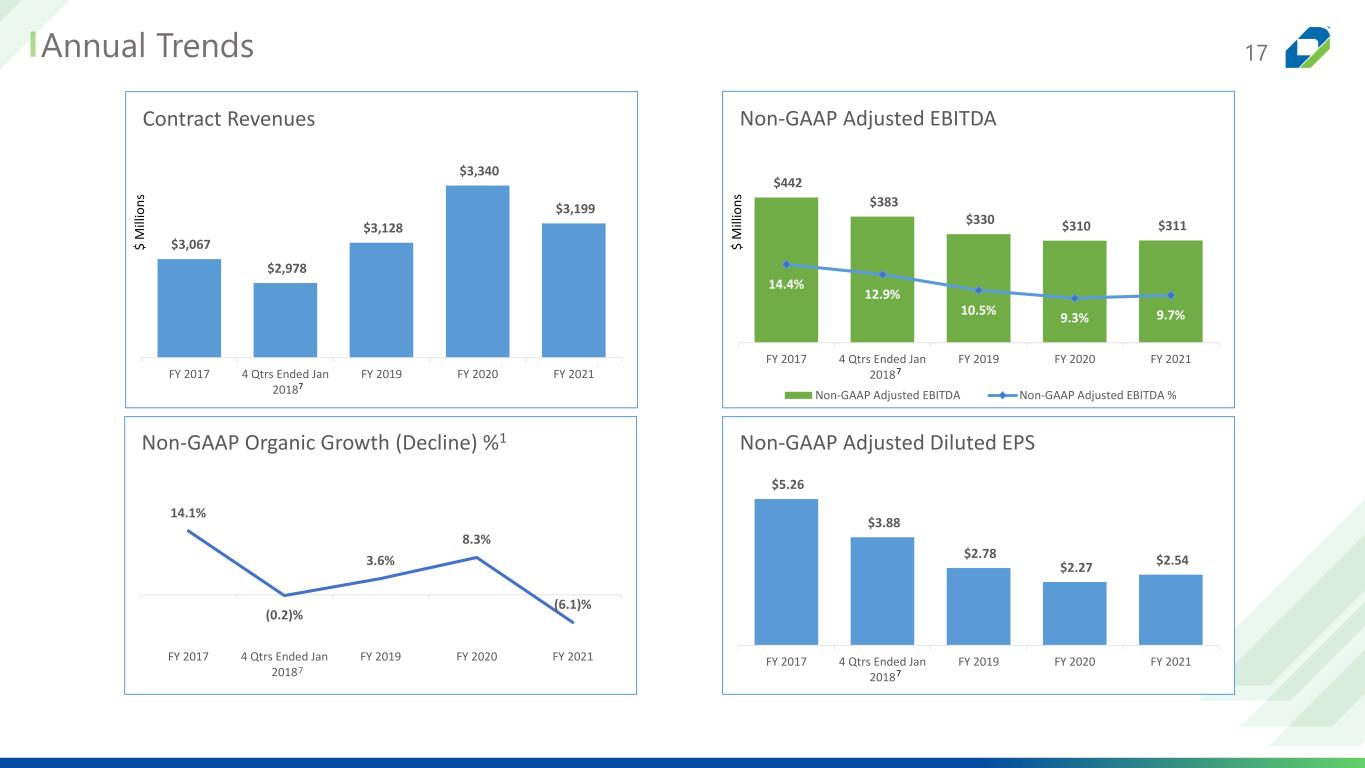
$5.26 $3.88 $2.78 $2.27 $2.54 FY 2017 4 Qtrs Ended Jan 2018 FY 2019 FY 2020 FY 2021 Non-GAAP Adjusted Diluted EPS 7 14.1% (0.2)% 3.6% 8.3% (6.1)% FY 2017 4 Qtrs Ended Jan 2018 FY 2019 FY 2020 FY 2021 Non-GAAP Organic Growth (Decline) %1 $3,067 $2,978 $3,128 $3,340 $3,199 FY 2017 4 Qtrs Ended Jan 2018 FY 2019 FY 2020 FY 2021 Contract Revenues $ M il li o n s 7 17Annual Trends 7 $442 $383 $330 $310 $311 14.4% 12.9% 10.5% 9.3% 9.7% FY 2017 4 Qtrs Ended Jan 2018 FY 2019 FY 2020 FY 2021 Non-GAAP Adjusted EBITDA Non-GAAP Adjusted EBITDA Non-GAAP Adjusted EBITDA % $ M il li o n s 7
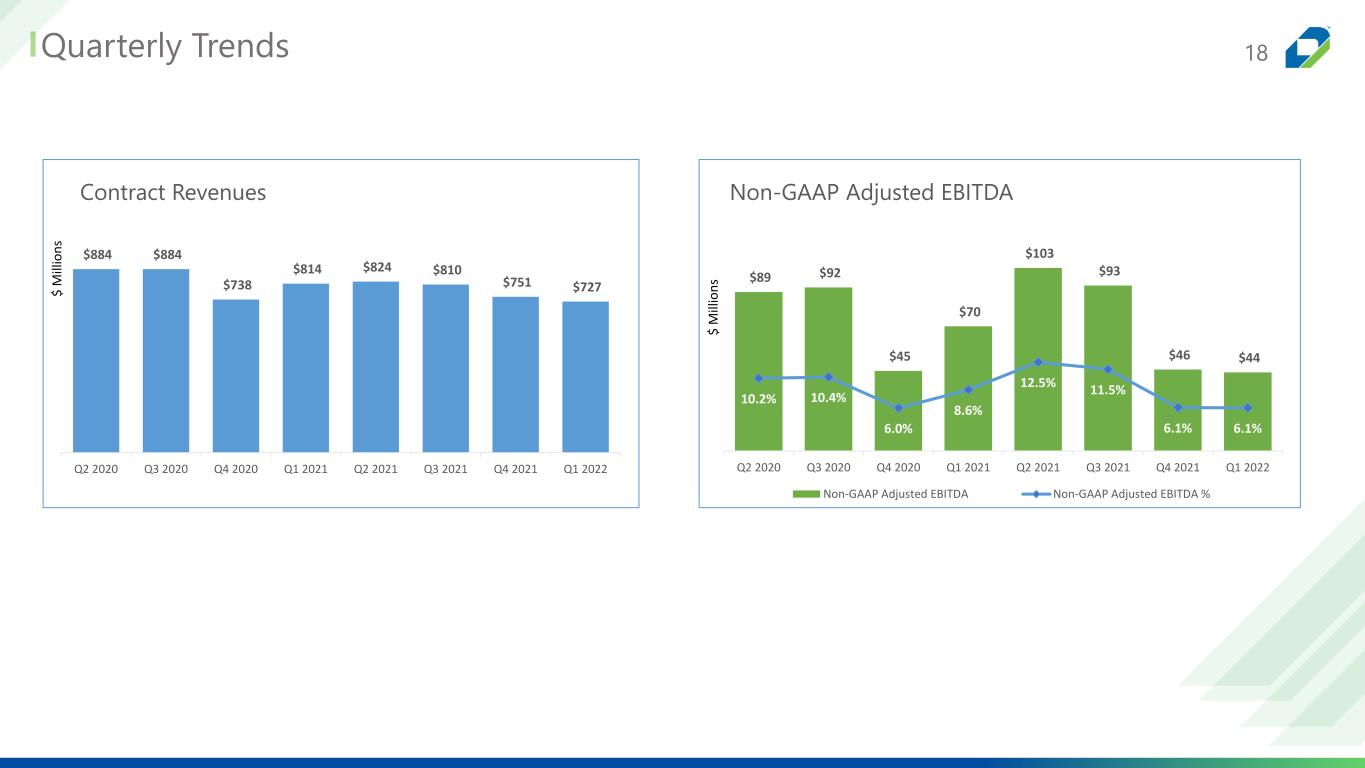
$89 $92 $45 $70 $103 $93 $46 $44 10.2% 10.4% 6.0% 8.6% 12.5% 11.5% 6.1% 6.1% Q2 2020 Q3 2020 Q4 2020 Q1 2021 Q2 2021 Q3 2021 Q4 2021 Q1 2022 Non-GAAP Adjusted EBITDA Non-GAAP Adjusted EBITDA % $ M il li o n s $884 $884 $738 $814 $824 $810 $751 $727 Q2 2020 Q3 2020 Q4 2020 Q1 2021 Q2 2021 Q3 2021 Q4 2021 Q1 2022 $ M il li o n s 18Quarterly Trends Contract Revenues Non-GAAP Adjusted EBITDA
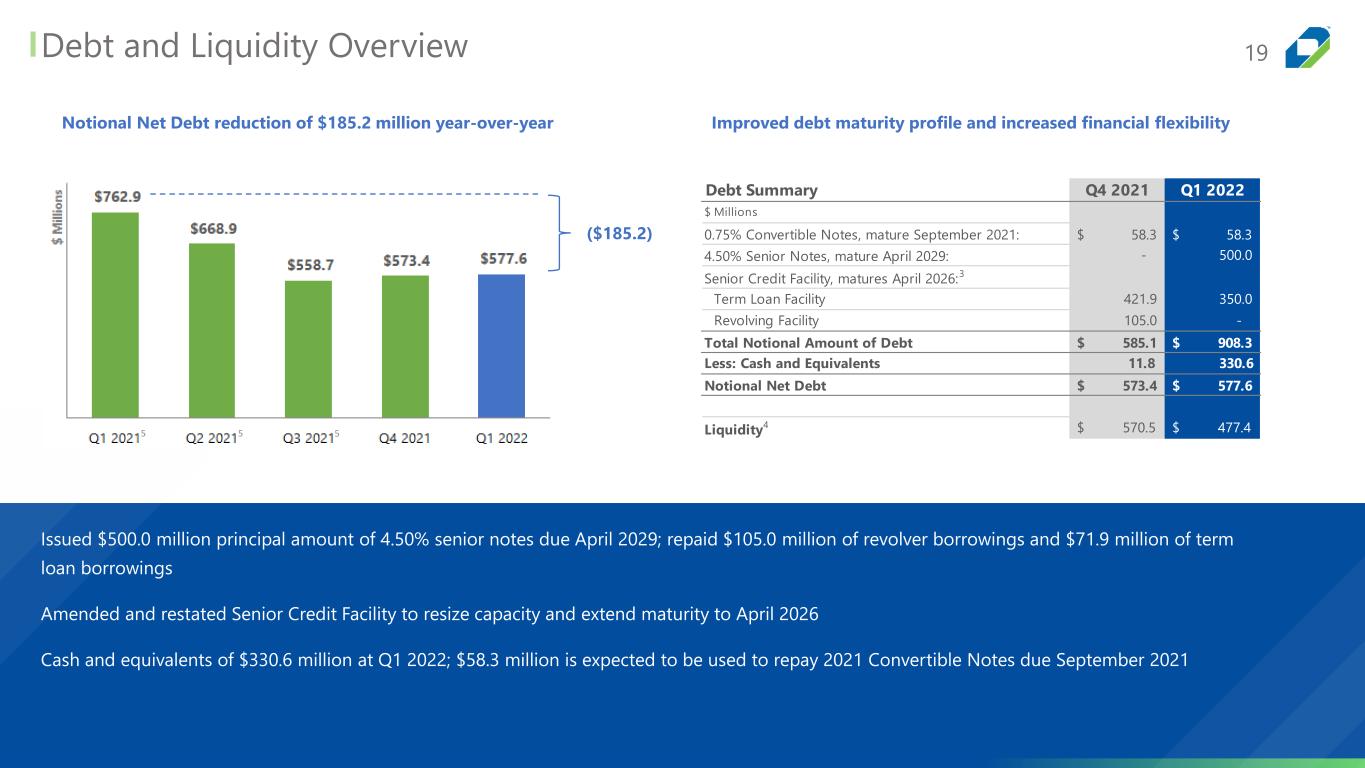
19Debt and Liquidity Overview Issued $500.0 million principal amount of 4.50% senior notes due April 2029; repaid $105.0 million of revolver borrowings and $71.9 million of term loan borrowings Amended and restated Senior Credit Facility to resize capacity and extend maturity to April 2026 Cash and equivalents of $330.6 million at Q1 2022; $58.3 million is expected to be used to repay 2021 Convertible Notes due September 2021 Improved debt maturity profile and increased financial flexibilityNotional Net Debt reduction of $185.2 million year-over-year ($185.2) 5 5 5 Debt Summary Q4 2021 Q1 2022 $ Millions 0.75% Convertible Notes, mature September 2021: $ 58.3 $ 58.3 4.50% Senior Notes, mature April 2029: - 500.0 Senior Credit Facility, matures April 2026: 3 Term Loan Facility 421.9 350.0 Revolving Facility 105.0 - Total Notional Amount of Debt $ 585.1 $ 908.3 Less: Cash and Equivalents 11.8 330.6 Notional Net Debt $ 573.4 $ 577.6 Liquidity 4 $ 570.5 $ 477.4
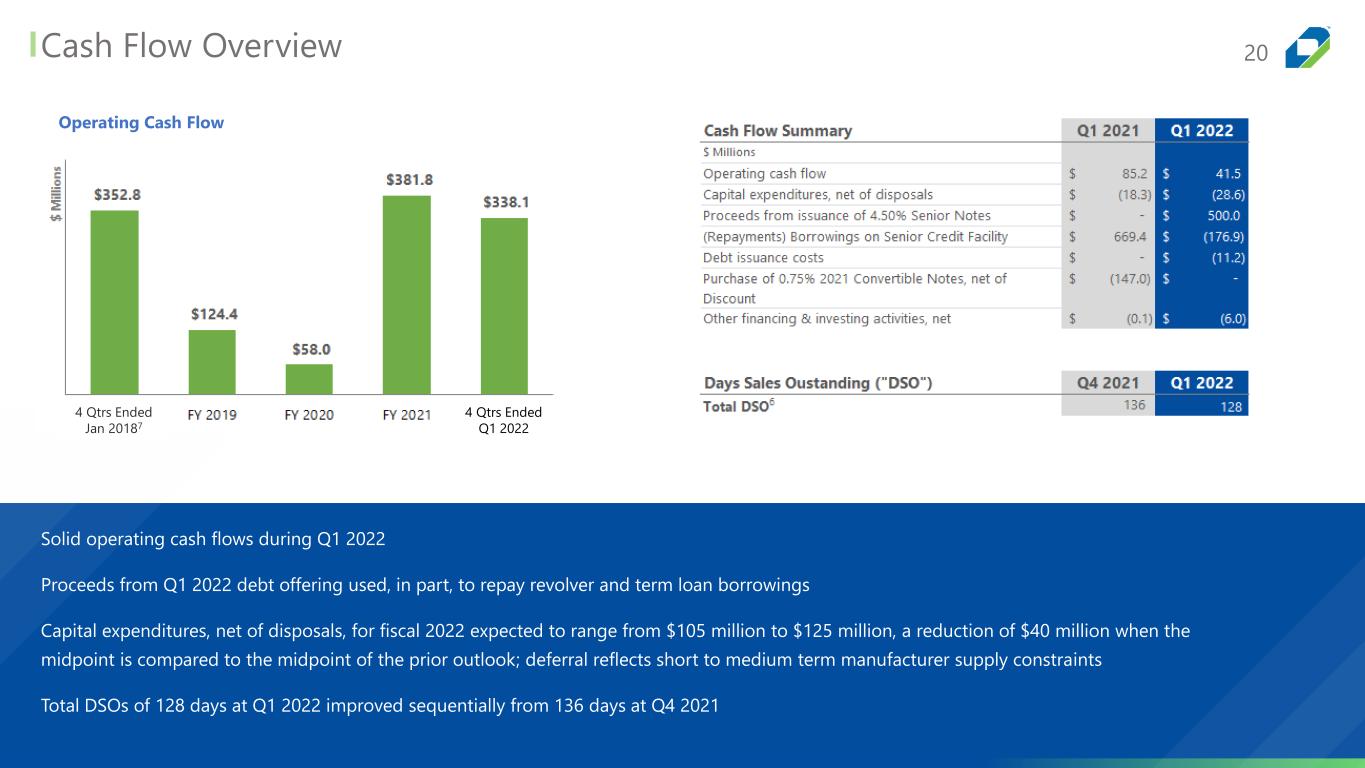
20Cash Flow Overview Solid operating cash flows during Q1 2022 Proceeds from Q1 2022 debt offering used, in part, to repay revolver and term loan borrowings Capital expenditures, net of disposals, for fiscal 2022 expected to range from $105 million to $125 million, a reduction of $40 million when the midpoint is compared to the midpoint of the prior outlook; deferral reflects short to medium term manufacturer supply constraints Total DSOs of 128 days at Q1 2022 improved sequentially from 136 days at Q4 2021 4 Qtrs Ended Q1 2022 Operating Cash Flow 4 Qtrs Ended Jan 20187

21 QUESTIONS AND ANSWERS
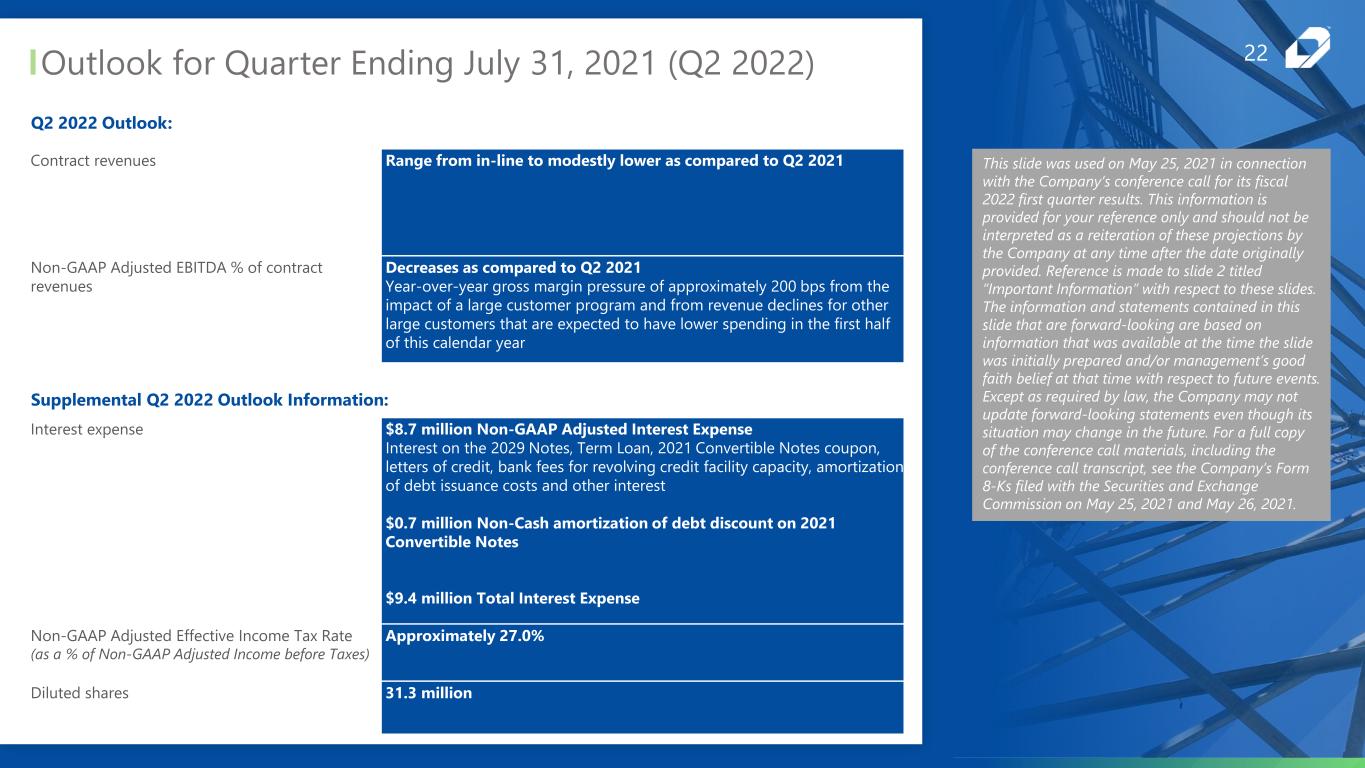
Contract revenues Range from in-line to modestly lower as compared to Q2 2021 Non-GAAP Adjusted EBITDA % of contract revenues Decreases as compared to Q2 2021 Year-over-year gross margin pressure of approximately 200 bps from the impact of a large customer program and from revenue declines for other large customers that are expected to have lower spending in the first half of this calendar year Interest expense $8.7 million Non-GAAP Adjusted Interest Expense Interest on the 2029 Notes, Term Loan, 2021 Convertible Notes coupon, letters of credit, bank fees for revolving credit facility capacity, amortization of debt issuance costs and other interest $0.7 million Non-Cash amortization of debt discount on 2021 Convertible Notes $9.4 million Total Interest Expense Non-GAAP Adjusted Effective Income Tax Rate (as a % of Non-GAAP Adjusted Income before Taxes) Approximately 27.0% Diluted shares 31.3 million 22Outlook for Quarter Ending July 31, 2021 (Q2 2022) Supplemental Q2 2022 Outlook Information: Q2 2022 Outlook: This slide was used on May 25, 2021 in connection with the Company’s conference call for its fiscal 2022 first quarter results. This information is provided for your reference only and should not be interpreted as a reiteration of these projections by the Company at any time after the date originally provided. Reference is made to slide 2 titled “Important Information” with respect to these slides. The information and statements contained in this slide that are forward-looking are based on information that was available at the time the slide was initially prepared and/or management’s good faith belief at that time with respect to future events. Except as required by law, the Company may not update forward-looking statements even though its situation may change in the future. For a full copy of the conference call materials, including the conference call transcript, see the Company’s Form 8-Ks filed with the Securities and Exchange Commission on May 25, 2021 and May 26, 2021.
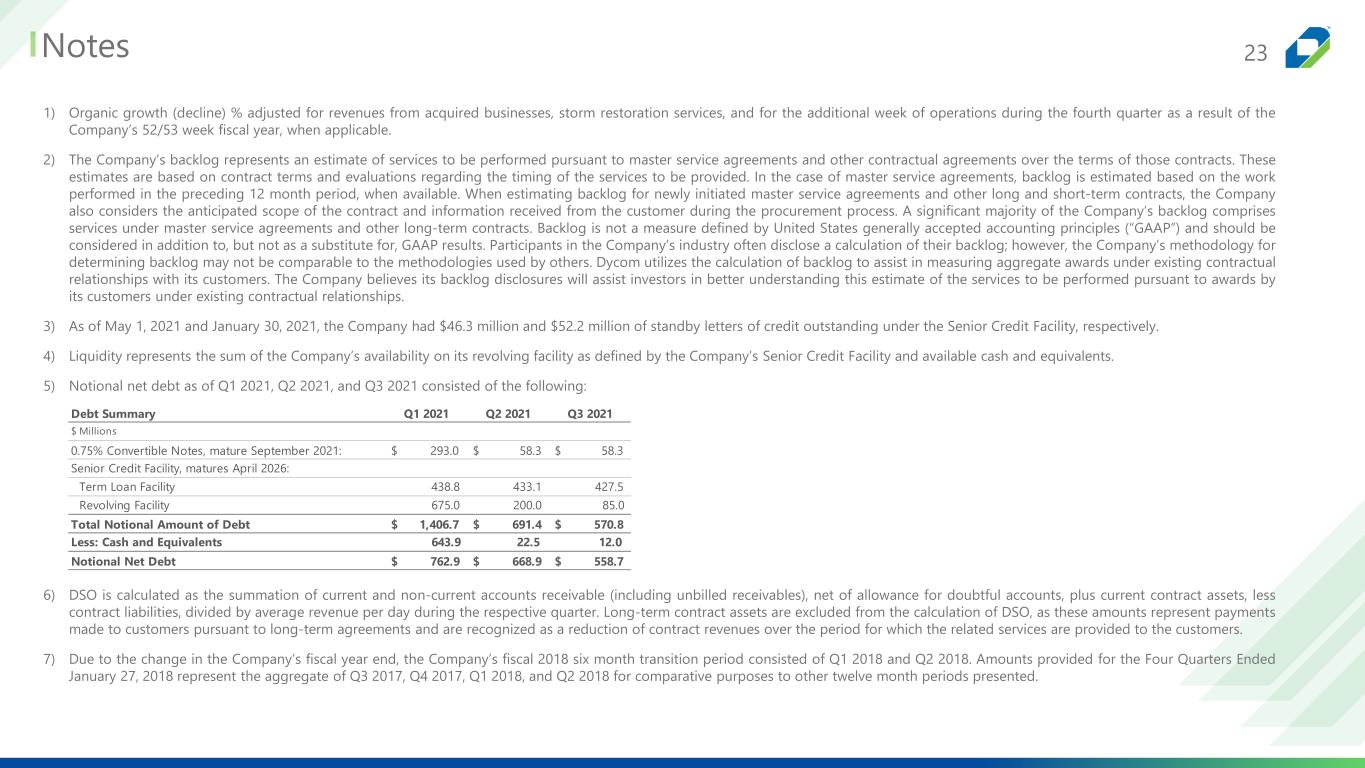
Notes 23 1) Organic growth (decline) % adjusted for revenues from acquired businesses, storm restoration services, and for the additional week of operations during the fourth quarter as a result of the Company’s 52/53 week fiscal year, when applicable. 2) The Company’s backlog represents an estimate of services to be performed pursuant to master service agreements and other contractual agreements over the terms of those contracts. These estimates are based on contract terms and evaluations regarding the timing of the services to be provided. In the case of master service agreements, backlog is estimated based on the work performed in the preceding 12 month period, when available. When estimating backlog for newly initiated master service agreements and other long and short-term contracts, the Company also considers the anticipated scope of the contract and information received from the customer during the procurement process. A significant majority of the Company’s backlog comprises services under master service agreements and other long-term contracts. Backlog is not a measure defined by United States generally accepted accounting principles (“GAAP”) and should be considered in addition to, but not as a substitute for, GAAP results. Participants in the Company’s industry often disclose a calculation of their backlog; however, the Company’s methodology for determining backlog may not be comparable to the methodologies used by others. Dycom utilizes the calculation of backlog to assist in measuring aggregate awards under existing contractual relationships with its customers. The Company believes its backlog disclosures will assist investors in better understanding this estimate of the services to be performed pursuant to awards by its customers under existing contractual relationships. 3) As of May 1, 2021 and January 30, 2021, the Company had $46.3 million and $52.2 million of standby letters of credit outstanding under the Senior Credit Facility, respectively. 4) Liquidity represents the sum of the Company’s availability on its revolving facility as defined by the Company’s Senior Credit Facility and available cash and equivalents. 5) Notional net debt as of Q1 2021, Q2 2021, and Q3 2021 consisted of the following: 6) DSO is calculated as the summation of current and non-current accounts receivable (including unbilled receivables), net of allowance for doubtful accounts, plus current contract assets, less contract liabilities, divided by average revenue per day during the respective quarter. Long-term contract assets are excluded from the calculation of DSO, as these amounts represent payments made to customers pursuant to long-term agreements and are recognized as a reduction of contract revenues over the period for which the related services are provided to the customers. 7) Due to the change in the Company’s fiscal year end, the Company’s fiscal 2018 six month transition period consisted of Q1 2018 and Q2 2018. Amounts provided for the Four Quarters Ended January 27, 2018 represent the aggregate of Q3 2017, Q4 2017, Q1 2018, and Q2 2018 for comparative purposes to other twelve month periods presented. Debt Summary Q1 2021 Q2 2021 Q3 2021 $ Millions 0.75% Convertible Notes, mature September 2021: $ 293.0 $ 58.3 $ 58.3 Senior Credit Facility, matures April 2026: Term Loan Facility 438.8 433.1 427.5 Revolving Facility 675.0 200.0 85.0 Total Notional Amount of Debt $ 1,406.7 $ 691.4 $ 570.8 Less: Cash and Equivalents 643.9 22.5 12.0 Notional Net Debt $ 762.9 $ 668.9 $ 558.7
